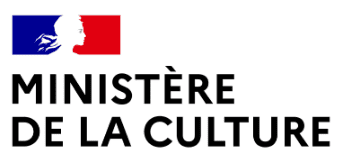Baya Medhaffar
Combining two contradictory terms in a single phrase is called an oxymoron. Circumventing the obvious, shaking up the logic, proceeding in gusts, claiming the impossible, such is the method that Baya Medhaffar has chosen and, adopting an ancient motto, she makes it clear right from the title: “Make haste slowly”. There are several explanations for this speed proclaimed yet slowed all at once. Her film is mostly made of edited, assembled images from other films; thus, all the emergencies from other works reach a climax here, but as they overlap, they also call for their patient and detailed examination. The dishevelled editing is combined to a superimposition technique that makes scales collide, that associate separated figures and backgrounds, and that ties together in the same frame seemingly unrelated dynamics and lines of forces. Yet again, increased speed on screen and necessary microscopic observation, as if in slow motion. Such are some of the aspects of the oxymoron in Festina Lente, yet it hardly explains why Baya Medhaffar chose to draw on it. Why then? A permanent feature arises in this lively and slow chaos: children. Or rather childhood. Which one? That of all the children on screen, who seem right out of Marcel Schwob’s novel La Croisade des enfants. That of a young and new revolution. That of the director herself, also an actress and a musician, who notoriously played a rebel rock singer (in A peine j’ouvre les yeux by Leyla Bouzid). Being at once a tortoise and a hare is a characteristic of that age when contrariness is not yet the rule, when children wish to learn and to forget, when they remember and they want to make their own rules.
(Jean-Pierre Rehm)
- Flash Competition | Renaud Victor Award
- 2021
-
 Flash Competition
Flash Competition
- Renaud Victor Award
- 2021
FESTINA LENTE
Baya Medhaffar
Interview with Baya Medhaffar
1. You started your film career as an actress, notably in the film À peine j’ouvre les yeux (As soon as I open my eyes)(2015) by your compatriot Leyla Bouzid. How did you end up behind the camera and what are the origins of Festina Lente يا عم الشيفور?
The transition was quite natural, my interest in filmmaking started before my experience as an actress, and although the latter was rewarding, I didn’t feel I was in the right place. This type of exposure does not come without a certain violence and I never managed to assimilate the sudden estrangement from my body, the idea that I was trapped in it and yet it was escaping me. I needed to feel its porosity, and my desire to make my voice heard through images made me step behind the camera. In Festina Lente يا عم الشيفور it’s as if I were taking stock of my time as a student in Paris. I try to retrace my journey and vanishing lines, I am searching for myself while I search through the images and sounds I pass through and that pass through me..
2. The film is composed of a wide variety of images and sounds whose origin is not specified. Can you tell us more about all the extracts used? What ideas or intuitions informed the editing?
The film was indeed created during the editing process. My intention was to place several heterogeneous regimes of sounds and images on an equal footing, to extract them from their source, to de-contextualise them and transform them into raw material. It combined the vernacular images I’ve filmed over the years with the archive images that I’ve collected. One of the film’s guiding principles was to explore a journey, a crossing. I arrived at the editing stage with a feeling, a rhythm that I attempted to reconstruct, trying not to bypass each difficulty encountered (difficulties linked to not having written the film beforehand), but rather to explore their potential. Making the film was more like composing music than writing a script. That’s where the title comes from, the Arabic part is taken from a song by Fatma Boussaha – a pioneer of traditional Tunisian music – where she says ” “Drive slowly Mr Driver”. The Latin part comes from a saying that means “make haste slowly”, the combination of the two creates a kind of rhythmic oxymoron. The place of the title in the film became obvious during the editing process. For me, it marks a time when walking went hand-in-hand with a form of hesitation and inaugurates another time when it became more decisive.
3. The film is about constantly getting lost, finding the right path. In this wandering, the only landmarks are memories so old that they seem to come from another world, even another time, that of childhood, as you say. What made you adopt the stance of childhood?
Childhood is an anchor point from which I explore the world around me, with all the seriousness of a child at play. It’s also a refuge that allows me to turn the film into a playground, a cinematic sandbox. It was also a way for me to examine my personal history in the light of History, while preserving a form of freedom in the editing, the liberty to try things that I wouldn’t necessarily have dared to if I didn’t have this “cover”. Actually, in many respects, it is a perspective that is quite close to my own. Deep down I’ve never managed to shed my childhood, I’ve always felt that I was in an in-between place, that of transitions that haven’t occurred. The feature film project I am currently working on also explores this theme.
Interview by Marco Cipollini.
-
 Flash Competition
Flash Competition
- Renaud Victor Award
Technical sheet
Tunisia, France / 2021 / 21’
Original Version : English, Arabic, French.
Subtitles : English, French.
Script : Baya Medhaffar.
Photography : Baya Medhaffar, Med Zanina, Les soldats inconnus de Youtube.
Editing : Baya Medhaffar.
Music : Great Fast Ships .
Sound : Ismail Ben Abdelghaffar.
Production : Baya Medhaffar (JS Productions).
- Autres films / Flash Competition, Renaud Victor Award






